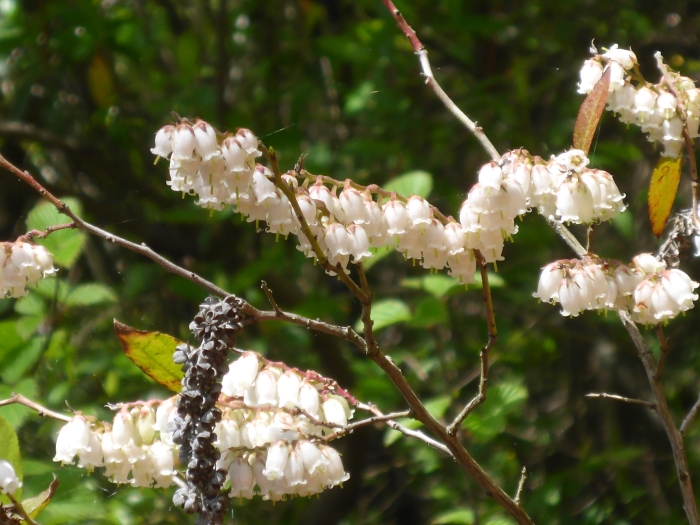Fetterbush
(Eubotrys racemosa)
Fetterbush (Eubotrys racemosa)
/
/

mfeaver
CC BY 4.0
Image By:
mfeaver
Recorded By:
Copyright:
CC BY 4.0
Copyright Notice:
Photo by: mfeaver | License Type: CC BY 4.0 | License URL: http://creativecommons.org/licenses/by/4.0/ | Rights Holder: mfeaver | Publisher: iNaturalist | Date Created: 2017-03-25T12:55:37-07:00 |























































Estimated Native Range
Summary
Eubotrys racemosa, commonly known as Fetterbush, is a deciduous shrub native to the understory of pine flatwoods, pocosins, and bogs in the Southeastern United States. It can grow up to 13 feet (4 meters) tall. The plant features thin, smooth leaves that are oval to widely lance-shaped with serrated margins, measuring 3 to 8 centimeters in length. The leaves are notable for their size variation on a single branch. Fetterbush produces an inflorescence consisting of rows of bell-shaped white flowers, each just under a centimeter long, which bloom in the spring and are moderately showy. The fruit is a dry capsule that follows the flowers.
Fetterbush is appreciated for its attractive white flowers and adaptability to wet conditions, making it suitable for rain gardens and naturalized areas. It is often used in restoration projects and as an understory plant in larger landscapes. While it thrives in full sun to part shade, it requires consistently moist to wet soils with slow drainage. It is not tolerant of drought or dry soil conditions. Gardeners should be aware that although it is not typically prone to serious disease or pest problems, it can suffer from root rot in poorly drained soils.CC BY-SA 4.0
Fetterbush is appreciated for its attractive white flowers and adaptability to wet conditions, making it suitable for rain gardens and naturalized areas. It is often used in restoration projects and as an understory plant in larger landscapes. While it thrives in full sun to part shade, it requires consistently moist to wet soils with slow drainage. It is not tolerant of drought or dry soil conditions. Gardeners should be aware that although it is not typically prone to serious disease or pest problems, it can suffer from root rot in poorly drained soils.CC BY-SA 4.0
Plant Description
- Plant Type: Shrub
- Height: 3-8 feet
- Width: 4-6 feet
- Growth Rate: Moderate
- Flower Color: White
- Flowering Season: Summer
- Leaf Retention: Deciduous
Growth Requirements
- Sun: Full Sun, Part Shade
- Water: Medium, High
- Drainage: Slow
Common Uses
Bank Stabilization, Butterfly Garden, Deer Resistant, Erosion Control, Fragrant, Low Maintenance, Water Garden
Natural Habitat
Native to the understory of pine flatwoods, pocosins, and bogs in the Southeastern United States
Other Names
Common Names: Swamp Doghobble, Swamp Sweetbells, Sweetbells, Sommarrosling
Scientific Names: , Leucothoe racemosa, Eubotrys racemosa, Leucothoe elongata, Zenobia racemosa, Leucothoe racemosa var. projecta, Lyonia racemosa, Leucothoe racemosa var. elongata, Andromeda elegans, Andromeda paniculata var. tomentosa
GBIF Accepted Name: Eubotrys racemosa (L.) Nutt.